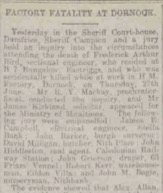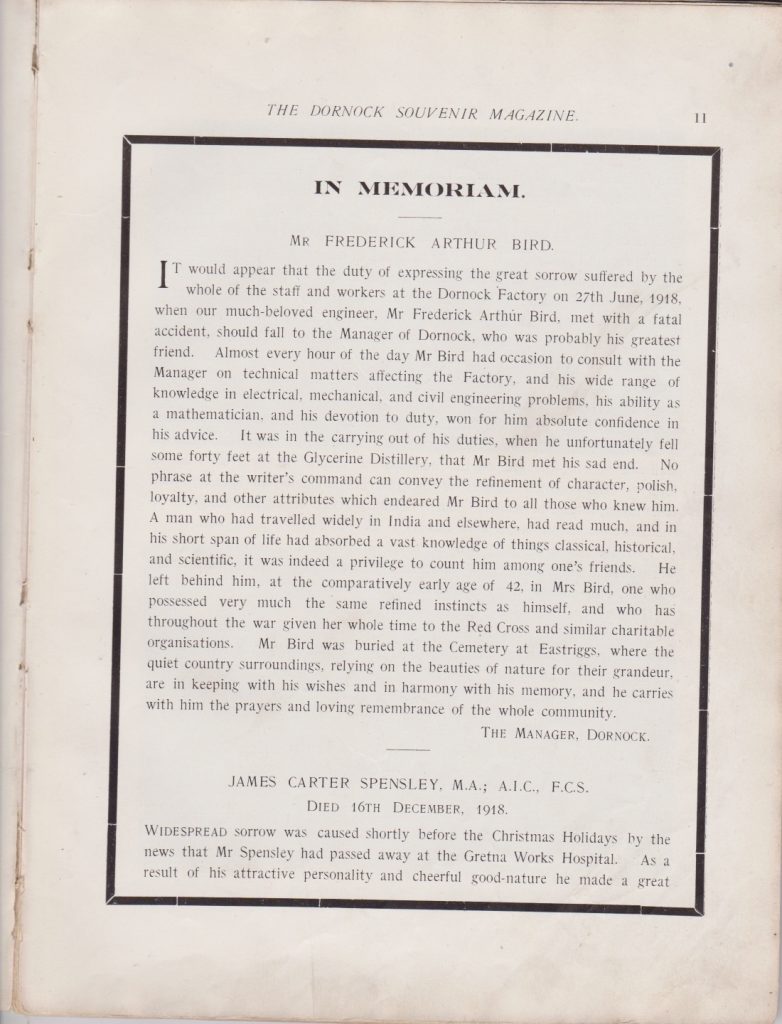Harwich England
B7 Bungalow Eastriggs Scotland
‘FACTORY FATALITY AT DORNOCK. Yesterday in the Sheriff Court-house, Dumfries, Sheriff Campion and a jury held an inquiry into the circumstances attending the death of Frederick Arthur Bird, sectional engineer, who resided at B7 Bungalow, Eastriggs, and who was accidentally killed while at work in H.M. Factory, Dornock, on Thursday, 27th June. Mr R. Y. Mackay, procurator-discal, conducted the inquiry, and Mr James Kirkland, solicitor, appeared for the Ministry of Munitions. The following jury were empanelled…The evidence showed that Alex Allan, engineer, Moat Road, Annan, and the deceased went to the roof of the glycerine distillery on the forenoon in question to examine a defective jet condenser. On each side of the roof, which is a sloping one, and covered with a composition of felt and tar, there is a portion of glass reinforced with wire netting. Bird had nails in his boots, and was slipping. He made a remark to Allan, and just when the latter was turning round to look at Bird he saw him go down through the glass. He fell onto a concrete floor below, a distance of about forty feet. The incident was really caused by Bird’s boots slipping. He had probably been endeavouring to get across the window to the upper slide, which was more flat and easier to walk on. In trying to cross the glass he had probably intended to use the frame of the window, and the slipping of his foot had thrown him off his balance. In trying to regain his balance he probably put the other foot on the glass, which gave way beneath him. He died almost immediately. The body was examined by Dr G. A. Welsh, Eastriggs, who found a fracture at the base of the skull and laceration off the brain tissue, which was the cause of death. Death would be almost instantaneous. Deceased had apparently fallen on his hands, as there were fractures of both wrists and an elbow, and also a fracture of the lower jaw. The jury returned a verdict in accordance with the evidence. They added that they unanimously recommended that if access to the jet condenser was necessary, wooden boards with straps should be laid on the roof to form a pathway and that iron bars be fixed across the rooflight at not more than 12-inch centres.’
Frederick Arthur Bird worked as an Engineer in the Dornock section of the Factory, and what makes his sad demise even more poignant was that it occurred in June 1918, only a few months before World War One ended.
Frederick wasn’t the only person to injure themselves or die at the Factory, we know of many others who also lost their lives or suffered life-changing wounds whilst working in munitions: local girl Roberta Robertson died after an explosion at the Factory in 1917. Jonathan Leah had to have his left eye removed after acid sprayed onto his face, and later died of meningitis.[1] Reginald Purcell died way after WW1 in 1925 as the Factory was being dismantled.[2]
So, what actually happened to Frederick? Well in an incident that would make any modern Health and Safety Inspector cringe, Frederick died in a work-place accident. Frederick went onto the sloping roof of the glycerine distillery to look at a defective jet condenser with a fellow engineer. Unfortunately, he slipped and crashed through a glass section of the roof, falling almost forty feet. Frederick died almost instantly. At an inquiry into his death in Dumfries, the jury recommended that ‘if access to the jet condenser was necessary, wooden boards with straps should be laid on the roof to form a pathway and that iron bars be fixed across the rooflight.’[3] This was obviously a subtle attempt from said-jurors to try and impose a few more safety regulations at Gretna.
 It appears that Frederick was a very popular member of staff at the Factory. In an ‘in memoriam’ written in the Dornock Farewell, a magazine written by staff members and held in The Devil’s Porridge Museum archives, it was stated:
It appears that Frederick was a very popular member of staff at the Factory. In an ‘in memoriam’ written in the Dornock Farewell, a magazine written by staff members and held in The Devil’s Porridge Museum archives, it was stated:
No phrase at the writer’s command can convey the refinement of character, polish, loyalty, and other attributes which endeared Mr Bird to all those who knew him. A man who had travelled widely in India and elsewhere, had read much, and in his short span of life had absorbed a vast knowledge of things classical, historical and scientific. It was indeed a privilege to count him among one’s friends.[4]
 This tribute to Frederick was written by none-other than the manager of Dornock, H. B. Fergusson, who describes himself as Frederick’s ‘greatest friend.’ As well as being a hard-working and beloved employee and colleague, Frederick also left behind a family. It’s there that you can really see the human cost of this man’s loss of life. His wife, Ellen died in 1965. She never married again.
This tribute to Frederick was written by none-other than the manager of Dornock, H. B. Fergusson, who describes himself as Frederick’s ‘greatest friend.’ As well as being a hard-working and beloved employee and colleague, Frederick also left behind a family. It’s there that you can really see the human cost of this man’s loss of life. His wife, Ellen died in 1965. She never married again.
[1] G. Routledge, Gretna’s Secret War, (Bookcase, 1999), p. 39.
[2] Ibid.
[3] ‘Factory Fatality at Dornock’ Dumfries & Galloway, July 27 1918, p. 6.
[4] Dornock Farewelll Magazine, The Devil’s Porridge Museum archives
Harwich England
B7 Bungalow Eastriggs Scotland
